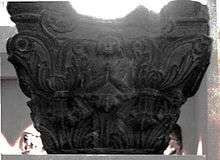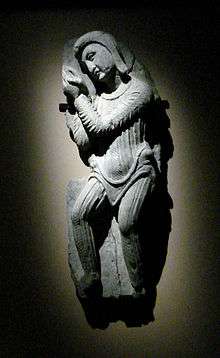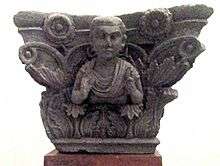Butkara Stupa
| بت کڑہ اسٹوپا | |
|
Remains of the Butkara Stupa | |
 Shown within Pakistan | |
| Location |
Swat] Khyber Pakhtunkhwa Pakistan |
|---|---|
| Coordinates | 34°45′N 72°22′E / 34.75°N 72.37°ECoordinates: 34°45′N 72°22′E / 34.75°N 72.37°E |
| Type | Ancient capital city |
| History | |
| Founded | 2nd century BCE |
| Periods | Gandhara |
The Butkara Stupa (Urdu: بت کڑہ اسٹوپا) is an important Buddhist stupa near Mingora, in the area of Swat, Pakistan. It may have been built by the Mauryan emperor Ashoka, but it is generally dated slightly later to the 2nd century BCE.
The stupa was enlarged on five occasions during the following centuries, every time by building over, and encapsulating, the previous structure.
Excavation



The stupa was excavated by an Italian mission (IsIOAO: Istuto Italiano per l'Africa e l'Oriente), led by archaeologist Domenico Faccenna from 1956, to clarify the various steps of the construction and enlargements. The mission established that the stupa was "monumentalized" by the addition of Hellenistic architectural decorations during the 2nd century BCE, suggesting a direct involvement of the Indo-Greeks, rulers of northwestern India during that period, in the development of Greco-Buddhist architecture.[1]
An Indo-Corinthian capital representing a Buddhist devotee within foliage has been found which had a reliquary and a coins of Azes II buried at its base, securely dating the sculpture to earlier than 20 BCE.[2]
The nearby Hellenistic fortifications of Barikot are also thought to be contemporary.
A large quantity of the artifacts are preserved in the National Museum of Oriental Art and the City Museum of Ancient Art in Turin's Turin City Museum of Ancient Art.
Coinage and datation
The oldest core strata (GSt 1) revealed a coin of Chandragupta Maurya and is therefore dated to the Ashokan period.[3] A coin of Menander I was found in the second oldest stratum (GSt 2).[3] A coin of Azes II was found under a plinth of the third stratum (GSt 3), which is therefore dated to the end of the 1st century BCE or the beginning of the 1st century CE.[3] The 4th stratum (GSt 4) contained late coins of Azes II and coins of the Kushan Kujula Kadphises.[3]
Gallery
 Indo-Corinthian capital representing a Buddhist devotee wearing a Greek cloak (chlamys) with fibula. Butkara Stupa, National Museum of Oriental Art, Rome.
Indo-Corinthian capital representing a Buddhist devotee wearing a Greek cloak (chlamys) with fibula. Butkara Stupa, National Museum of Oriental Art, Rome.- Head of the Buddha. Butkara I, 2nd century CE
- Buddhist relief with warrior. Butkara I, 1st century CE.
 Statue at the site
Statue at the site
See also
| Wikimedia Commons has media related to Butkara. |
Notes
- ↑ "De l'Indus a l'Oxus: archaeologie de l'Asie Centrale", Pierfrancesco Callieri, p212: "The diffusion, from the second century BCE, of Hellenistic influences in the architecture of Swat is also attested by the archaeological searches at the sanctuary of Butkara I, which saw its stupa "monumentalized" at that exact time by basal elements and decorative alcoves derived from Hellenistic architecture".
- ↑ The Turin City Museum of Ancient Art Text and photographic reference: Terre Lontane > O2 Archived 12 December 2006 at the Wayback Machine.
- 1 2 3 4 Handbuch der Orientalistik, Kurt A. Behrendt, BRILL, 2004, p.49 sig.
References
- Report of the Italian Archaeological Mission (Pdf, Italian)
- Domenico Faccenna, Butkara I (Swat, Pakistan), 1956–1962, Roma, 1962-1981.